 Staging Your Home to Sell in the Fall Market
Staging Your Home to Sell in the Fall Market
According to the National Association of Realtors, for every $100 spent on staging your home, you have the potentional to earn up to $400 back. That’s too big of a return to ignore–especially since a few simple tweaks could make a huge difference.
What is Staging Your Home?
There’s no question that the real estate market on Charleston is on fire but if you don’t have your house properly staged…the house could sit for longer than it should on the market. Staging your home means getting it in the best possible showing condition which could mean power washing, fresh paint, new furniture or finally removing those popcorn ceilings because who actually WANTS popcorn ceilings anymore? Staging can seem daunting, but with a few tweaks–you could have your home looking market ready in no time.
Here are five tips you can use to get your house ready for the fall market.
1.) De-clutter your home
I cannot stress this enough. I tell my clients to rent a POD (to be removed before listing of course) or a storage unit if they have to but whatevery they need to do, they should remove about 50% of their clutter. Closets should be half empty and garages should be as neat as possible. The more space that a buyer can see, the larger your home will look. And simple furnishings allow the buyer to imagine the space as their own.
2.) Remove Any Family Photos
It’s hard for a buyer to imagine themselves living in a home when they have a full visual of the family that currently is living there. Also, just for privacy reasons it’s always a good idea to remove the family photos from walls and surrounding areas.
3.) Paint the entire interior one color
Research shows painting the interior of your home the same light color throughout helps the home to feel large and flow smoothly. Greyish white with white trim throughout the home will help open it up tremendously and be less distracting than the hot pink 5 year old’s bedroom.
4.) Landscaping
Never underestimate the power of curb appeal and a first impression. If you don’t want to spend a lot of money, simply keeping the lawn mowed (especially during the summer) and the hedges trimmed will go a long way. Buyers can pick up on the fact that if the outside has been negelected–what else has been ignored in the home?
5.) Remove all curtains–especially dark ones
Natural light is your best friend. You want your home to look at bright as possible and with dark curtains (no matter how nice they might look) all of that will be taken away. Also, if the buyer doesn’t like the style of drapes it can be distracting. Invest in nice blinds and always have them open during showings.
Ready to Sell
If all of this seems overwhelming, hiring a professional to come stage your home may be the route to go. I work with several stagers and would be happy to recommened a few to help you get your house ready to sell fast. Contact me to today for a free estimate of what your home is worth and how we can get it market ready together– email frank@askfrankrealestate.com or call 843.224.7997.


 What is the one thing that most represents Christmas to you?
What is the one thing that most represents Christmas to you?